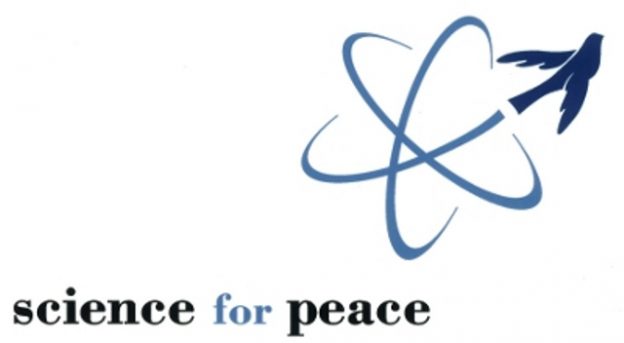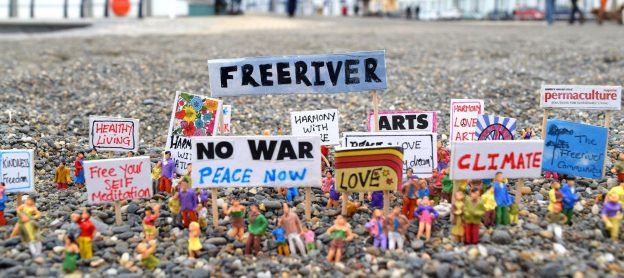“Non-violent defense” is an oxymoron. Or so it appears to many people. You hear the word “defense”, you think of “military”. You hear the term “national security”, you think of a state’s military strength (and perhaps diplomacy). The military has hi-jacked the terms defense and national security. Consequently, it sounds absurd to talk about non-violent defense.
But is the idea so preposterous?
Consider the war in Ukraine. Civilian resistance to the Russian invaders is inspirational. Civilians have blocked tanks and convoys, berated or cajoled Russian soldiers to undermine their resolve, given wrong directions to Russian convoys, refused to cooperate, and mounted spontaneous protests in occupied areas. And all these tactics were improvised on the spot.
Think how more effective non-violent defense would have been if it had been planned, and if Ukrainians had been trained in non-violent methods. With a civilian defense system in place, the Ukrainian armed forces might have allowed the Russian tanks to enter the country unimpeded. No immediate deaths, no destruction. And what can you, the invader, do with tanks when you face a population united in defiance, unarmed protest and complete non-cooperation? Ukraine would be indigestible.
Whether non-violent defense would have worked cannot be known. But what is certain is this: the prevailing notion of national security is leading us to death and destruction, in Ukraine and elsewhere. Thus, a potential alternative — civilian-based defence — deserves critical scrutiny. My earlier reflection on this system reviewed its strategy and tactics, some limiting conditions and provisos, and its potential benefits. Now I turn to lacuna and obstacles in the theory and practice of non-violent defense. Only hard-headed questioning will mitigate the skepticism surrounding this approach.
This critical review emphasizes the work of Gene Sharp – sometimes referred to as the “Clausewitz of non-violent warfare”. Recent major contributors on the methods of civilian resistance – in particular, Srdja Popovic and Erica Chenoworth – follow in Sharp’s footsteps. They provide either updated non-violent methods for a digital age (and for young rebels) or empirical evidence of the effectiveness of such an approach.
Two issues strike me as pivotal in getting real about non-violent defense. The first is recognizing and overcoming major domestic obstacles, especially vested interests, partisan divides, and apathy. The second involves seeing beyond the static typologies of non-violent action to conceptualize its implementation as a dynamic, mutually reinforcing process. Taking civilian defense seriously confronts its proponents with several dilemmas.
Not Just an Abstraction
Non-violent defense is not simply a theory. Not only is there a long history of improvised civilian resistance to invasions, but also countries such as Sweden, Switzerland, Finland and Lithuania have institutionalized civilian defense at various times.
Consider Sweden: “Total defense” (military plus civilian defense) originated in neutral Sweden in the dangerous 1930s and World War II. Created in 1944, a Swedish Civil Defence Board undertook research on civil defense, organized training and oversaw the construction of air raid shelters. Sweden ran civilian-defence training centres in six cities during the Cold War. In 1986 the agency merged with the fire services board in a new Rescue Services Agency. The end of the Cold War led to a withering of the civil defence component. The initial idea – that all citizens had a duty to protect their country in an organized manner – fell into disuse by the mid 1990s.
The Russian attack on Georgia and seizure of Crimea however, revived the concept of total defence after 2014. Everyone between the age of 16 and 70 again has an obligation to respond in the event of an invasion or a natural catastrophe. “Everyone is obliged to contribute and everyone is needed” proclaimed a government pamphlet in 2018. Swedes were cautioned in the same pamphlet to prepare themselves for an emergency, though the emphasis was as much on peace-time natural emergencies as war. Nevertheless, in the event of war, the pamphlet declared that “we will never give up”. This basic idea is central to non-violent defence: an invader may occupy territory, but total non-cooperation and symbolic opposition will raise the costs of occupation, thereby discouraging invasion in the first place. In principle, all municipalities, voluntary organizations, businesses, trade unions, and religious organizations are required to prepare for civilian defence.
By March 2022, at the height of the war in Ukraine, one in three Swedes was fairly or very concerned their country would be attacked.. Furthermore, a 2021 survey registered popular support for the idea of civil defense: 84 percent of Swedes said they would be willing to play a defense role, so long as it was non-combative.
Sweden is not an ideal case of civilian defense. Following Russia’s invasion of Ukraine in 2022, the government talked of raising the defense budget and perhaps abandoning Sweden’s neutrality by joining NATO. But the idea of civil defense persists as a defiant complement, though not alternative, to military defense.
Partisanship, Vested Interests and Apathy
If a country were to experiment with non-violent defense, what obstacles would the experiment encounter?
Sharp in Chapter 5 of Civilian-Based Defense contends that non-violent defense, to succeed, must not only adhere to an all-of-society, nonpartisan approach, but also secure the cooperation of the armed forces. People of both sexes and all ages must participate, according to Sharp. They will do so out of patriotism, the desire to maintain their way of life, and an abhorrence of domestic and foreign usurpers alike. It will also be necessary to bring the military onside, claims Sharp. Civilian-based defense (CBD) may thus begin as a minor supplement to the armed forces, the former’s role expanding as it demonstrates its efficacy and popularity.
Is this a realistic scenario in today’s world? The establishment of CBD, from this viewpoint, is largely a top-down exercise, based on two assumptions. The first is that partisan cleavages are bridgeable. According to Sharp, civilian defense must be “trans-partisan”. It must accommodate conservatives as well as liberals and socialists. If it becomes the project of a radical movement, or any single party, Sharp contends, its appeal will be too limited.
Secondly, this scenario assumes that reason will trump interests. The armed forces, various security apparatuses, suppliers of weapons and military technology and the national-security intellectual wing, are apparently swayed by evidence. Sharp emphasizes the importance of research in demonstrating CBD’s potential effectiveness. If research on CBD is positive, if the training of the population proceeds, and if civilians show enthusiasm, the armed wing of defense will acquiesce to the ascendancy of non-violent defense. Reason and patriotism will prevail.
Note that Sharp advocates “transarmament,” not disarmament. Presumably, it will be easier to sell CBD if it is seen not as pacifism, but as another form of struggle. The weapons in the new defence system are not munitions, missiles, warplanes, tanks; instead, they involve the subtle employment of 198 non-violent methods, their selection geared to the stage of engagement with the opponent, and the degree of the latter’s repressiveness.
I see three problems with this approach. The first pertains to interests. Sadly, we do not live in a world governed by reason; indeed, today people contest even what counts as fact. Interests shape dominant ideas, including those, or especially those, concerning national security. President Dwight Eisenhower, long ago, warned of the power of the military-industrial complex in bolstering military expenditures. Today, we would need to refer to an expanded military-industrial-security-intellectual complex. Thousands of billions of dollars are spent worldwide on the military and ancillary activities: on weapons, personnel, training, think-tanks, research and development. Many corporations, wealthy shareholders, employees and intellectuals are invested in perpetuating and extending the system of military defense. And defense budgets grow year after year.
In contrast, how much is spent on research on non-military forms of defense? Virtually nothing – perhaps the occasional grant for esoteric scholarly research.
Demilitarization will therefore involve a political struggle. It will be a struggle obviously in the superpowers. But even in in developing countries with weak institutions, the military tends to be comparatively strong. Much is at stake in defense policy for a range of powerful interests. No research results in favor of civilian defense are likely to persuade those whose profits, privileges or job depend on military defense. Non-violent defense – as more than a minor supplement to military defense – is a radical proposal.
Secondly, many societies today are riven with partisan divides and authoritarian tendencies. The United States is an obvious example, but the phenomenon is widespread, in Europe and beyond.
Is it possible to forge trans-partisan support for CBD in these circumstances?
Sharp notes in Civilian-Based Defence (ch. 5) that non-violent defence is more likely to work where social cohesion is high and democracy and civil society are strong. However, these ideal conditions are not, he claims, prerequisites.
But is Sharp correct? Can non-violent defence happen in the absence of social cohesion and strong democracy? It seems unlikely. The issue would be politicized and viewed with deep suspicion by conservative/populist forces. And autocrats would not empower their people via training in nonviolence.
Thirdly, alienation and cynicism are rife in many societies today; Yet Sharp emphasizes that non-violent defense requires intensive preparation and training of all or most of a country’s population. What will induce people to shake off their apathy and devote their free time to training? Motivation is a problem, magnified by deep partisan divides.
All these considerations – vested interests, partisan divides and alienation – suggest that a top-down, apolitical approach will not work. The reality is that non–violent defense is a radical democratic initiative. Nonviolent action is inherently democratic to the extent that it empowers people vis-a-vis their rulers or aggressors. Only a mass movement will be powerful enough to overcome the vested interests in militarism and motivate people to participate in training and preparation.
Of course, even if CBD fails as a national system, or is limited to a subsidiary role, people may, when the need arises, spontaneously take up nonviolent resistance. But a trained response would be so much more effective.
A Dynamic, Mutually Reinforcing Process
The prospect of non-violent defense is enhanced if it is understood as a dynamic process, rather than a static design. Don’t get lost in Sharp’s 198 methods of non-violent action and the complexities of relating strategy to circumstances. The key is this: CBD focuses on agency. People possess power to shape their own futures; how therefore should this agency be harnessed for the common good? People have power because rulers depend on the ruled. Rulers cannot rule if the latter withhold their consent (or perhaps more accurately, assent). Thus, Sharp and his followers explore the bases of consent, and how consent can be denied to internal usurpers or external aggressors through nonviolent means.
Sharp and the others adhere to an inductive approach. They draw principles of effective action from successful and unsuccessful cases. In their examples, groups and individuals improvised responses to attempted domination — for example, the passive resistance of the German population to the French-Belgian occupation of the Ruhr Basin in 1923, the heroic non-violent resistance to German occupation in Denmark and Norway during World War II, and the astounding non-cooperation and defiance of the Czechs and Slovaks that met the Warsaw Pact army’s invasion to end the Prague Spring in 1968. The point of these cases is obvious: if improvised strategies can work so effectively, imagine if they were organized!
Fine. But how do you begin the process? Enthusiasm for nonviolent defense may be limited at first, and powerful groups will not cooperate and may be actively obstructive.
The process seems to work like this. The more the government builds the capabilities of the civilian defenders, the greater the willingness of people to unite and resist, drawing on the learned repertoire of nonviolent strategy and tactics. And the more advanced the capabilities and the united willingness of defenders to resist, the less likely that enemies will attack or usurpers will usurp power. The costs of domination become too high.
What comprise the capabilities of non-violent defense? They include organizational structure, committed and shrewd leadership, training facilities geared to the general population, the proportion of the population that wants to participate, and ultimately the strength of civil society.
The final factor alludes to the importance of institutional involvement in civilian-based defense. What political parties, trade unions, religious bodies, school systems, municipalities support the system? Obviously, nonviolent action is much easier to develop within a democracy; indeed, it is inherently democratic. Again, CBD empowers people.
As the capabilities grow, the willingness to resist and the participation of the population expands. Concomitantly, the costs of asserting domination on the part of usurpers or aggressors rises, enhancing the prospects of peace – provided the society in question is willing to pre-empt conflict by negotiating jointly acceptable solutions to outstanding disputes.
Being Realistic
Demilitarization – reducing the budgets and roles of the armed forces – is a critical goal in today’s world. We face the rising probability of a nuclear holocaust resulting from accident, miscalculation, or escalation arising from a war like that in Ukraine. We are also very close to runaway global warming. The military, in the United States and increasingly elsewhere, is one of the largest institutional emitters of greenhouse gases. In addition, massive defense budgets are dedicated to waste – contributing neither to production not higher living standards – whereas we need to reallocate these resources to fighting climate change. Nonviolent defense, together with a renewed commitment to nuclear disarmament, is a potential way of achieving demilitarization.
Besides bolstering demilitarization, civilian defense has other positive outcomes. It reinforces civil society, builds democracy, discourages would-be tyrants and enemies, and extends norms of non-violent conflict resolution.
How then can we promote CBD? Civilian defense may proceed as a gradual process. Initially, it may be seen as only a supplement to military defense. Realism suggests that this approach is the most viable option. If popular enthusiasm grows and civilian capabilities advance, the military may be gradually reduced to a border control agency. But such a harmonious process is likely to be blocked at an early stage. Apolitical gradualism has severe limits.
Authoritarian states, for one thing, would balk at empowering their subjects. Civilian defense reveals the acute dependence of government on the assent of the ruled, together with the non-violent acts of omission and commission that withdraw that assent and paralyze rulership.
Nonetheless, in authoritarian systems, citizens have often improvised effective non-violent tactics. Consider the revolts of the people in eastern Europe and republics of the former Soviet Union in the late 1980s and early 1990s; the “Arab Spring” of the early 2010s, which featured in many cases massive street protests; the “color revolutions” beginning in 2004 in the post-Soviet countries of Eurasia, including Ukraine; and the non-violent revolts against military rule in Sudan, Myanmar and elsewhere. Indeed, nonviolent protest reached its apogee in the period 2010-19, inhibited eventually by the pandemic.
Nonviolence, at a minimal level, is just common sense for people with grievances but without deadly weapons.
Partisan divides and power structures also hinder the expansion of nonviolent resistance at the expense of the military. “The people united will never be defeated,” yes. But the people are rarely united, and vested interests are powerful. Partisan and other cleavages allow those who govern to divide and rule their subjects. Social cohesion, together with democracy, is a key ingredient of success with non-violence. Unfortunately, many societies today are riven by partisan loyalties and authoritarian tendencies. What to do?
Accept the reality: civilian defence, in its full manifestation where the military’s role considerably shrinks, is a radical proposal. It will probably be advocated only by a progressive movement, along with measures to9 achieve democratization, equity, and a Green New Deal for a just transition. Civilian defence, as a radical project of democratization and demilitarization, is the missing link in the programs of the left.
What sort of states are the best candidates for CBD? Nuclear-armed states are unlikely candidates. From the strategic viewpoint, it is assumed nuclear weapons deter attacks. We know the logic is strong. How else could a nuclear power such as Russia, without the deterrent, get away with attacking and devastating Ukraine, the second largest country in Europe? States will be reluctant to surrender their nuclear weapons.
Non-violent defence can still play a supplementary role in the US, the UK, France, India and Israel, acting as a major deterrent to domestic usurpers of power and building civil society for the longer run. In addition, the more states adopting CBD, the lower the international threats; the lower the tensions, the more likely are agreements on limiting and eventually abolishing nuclear weapons. There is an indirect benefit of civilian defence.
Clearly, CBD would be easiest to introduce in small democratic countries and territories that lack a military. Cases that come to mind include Costa Rica, Mauritius and Iceland.
Countries bordering on a Great Power could also benefit from civilian defence. These countries could not hope to defeat an invading force from the superpower – or at least not without inflicting enormous damage and casualties upon themselves. Besides training the population in the principles and methods of nonviolent defence, civil society organizations would need to build strong links with peace groups internationally and with dissident groups within the superpower. The aim would be to precipitate internal dissent in the aggressor’s country and international condemnation of the invader, together with sanctions, in the event of a conflict. This strategy would proceed along with a willingness to negotiate to resolve conflicts with the great-power neighbour. Ukraine would have been a major candidate for such an approach. Smaller countries would be in a more dangerous position with CBD. They would face the prospect of forced assimilation to the dominant ethnic group of the superpower, as has happened in Tibet and the western regions of China.
Democratic middle powers, especially the Nordic countries, also offer an opportunity. Sweden is an exemplar. They would begin with civilian defence as a supplement to military defence. As CBD is a dynamic process, it might expand over a decade as it demonstrates its viability. Given catastrophic climate change, civilian and military defence would both expand to encompass preparation and training in handling “natural” disasters (extreme heat and storms, floods and forest fires). The body in charge might be termed a “civilian protection agency.”
Nonviolent defense is one element in a broader program to allow humans to live and thrive in an increasingly dangerous world. Politics is key.
Richard Sandbrook is professor emeritus of Political Science at the University of Toronto and President of Science for Peace.









